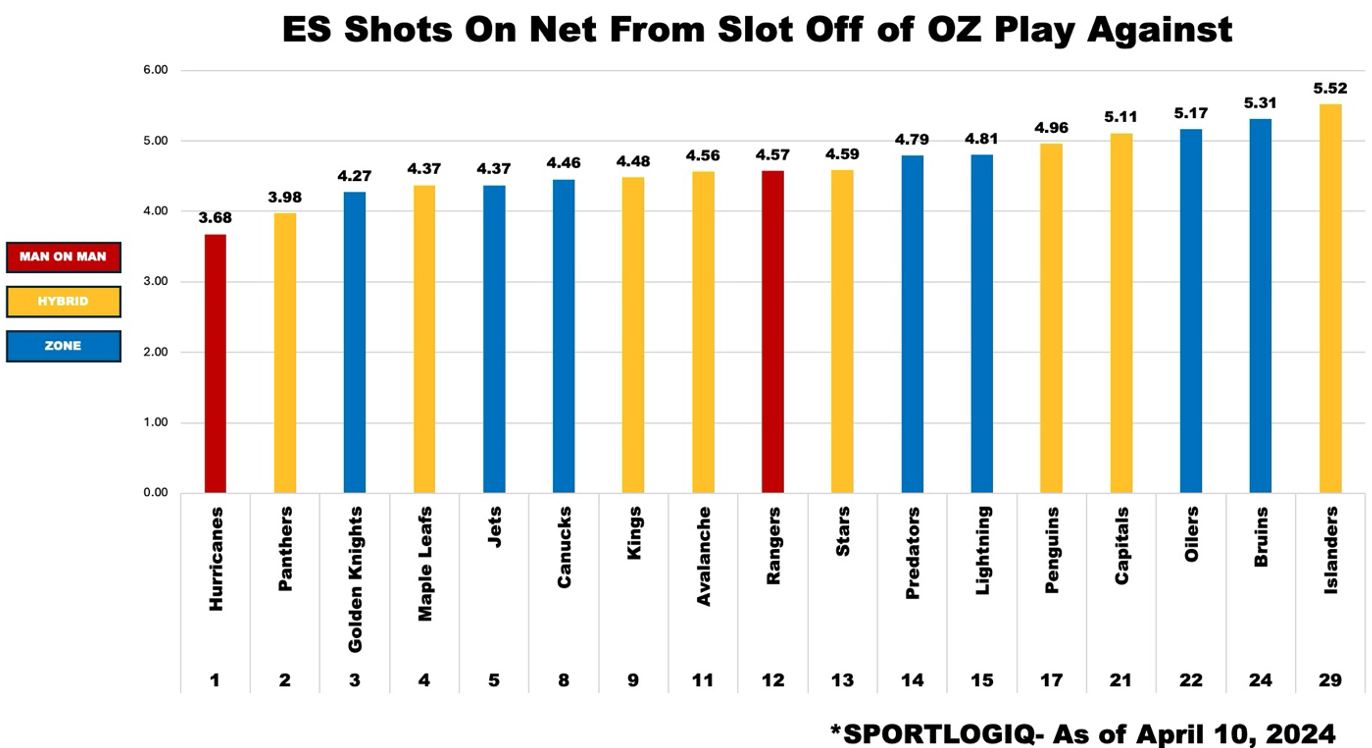On Nov. 1, the Edmonton Oilers were behind the Blackhawks, Coyotes, and Ducks in the standings, and their defensive-zone system was in the news for not looking very … systematic. Or rather, if it was systematic, it was systematically resulting in goals against.
And so, that day I consulted a man that can break down and explain NHL defensive systems as well as anybody, Andrew Brewer, and we conducted a chat on the state of the Oilers' D-zone. (It’s been better since, needless to say.)
With the playoffs looming roughly one week from now, I thought it would be helpful to take the ideas from that Oilers article and apply them to all the playoff teams.
Who plays what style? How will that affect first-round matchups?
Brewer has won Olympic gold with Canada as a video and assistant coach, he spent eight years with Detroit, Toronto and Florida in the NHL, and he’s now the manager of Hockey Business Development at FastModel Technologies, while running the consulting company 200fthockey.com. He knows his stuff, which also shows up on his Twitter feed here.
Justin Bourne: Brew, thanks for joining me today, really appreciate this!
Andrew Brewer: No problem JB, always enjoy our hockey chats.
JB: Same here man. Today I wanted to pick your brain on arguably the most important piece of systems execution in the playoffs: D-zone coverages. So let’s start with an overview: What are the types of defensive-zone coverages that teams play?
AB: Right on. Here’s a quick overview:
Zone Coverage: Players return to the defensive zone to a “quadrant” and are responsible for defending an “area” of the ice. No matter where the puck goes in the zone, players defend their area of the ice.
Man on Man: When returning to the defensive zone players pick up a player on the opposing team and are responsible for defending that “man” in the defensive zone.
Hybrid: Players return to the defensive zone to a “quadrant” and are responsible for defending an “area” of the ice on the initial entry, but when the puck goes to the top of the zone you attach to the closest player and switch into man-on-man coverage.
JB: Right. Now, two of those — hybrid and zone — likely sound similar to people. What are their differences, and why do teams play them?
AB: Sometimes the lines between zone and hybrid can be blurry, but the main difference between the two is how they handle active “D” and motion in the offensive zone.
Both systems rely on five players in a tight box pressuring the puck low to kill plays early. When the puck goes to the top, the difference is in how players sort out the coverage. In hybrid systems players will attach to the closest player and go man-on-man, no matter where that man goes in the zone. In zone systems coaches will have rules around where players can go (which can mean one player “handing off” a check to a teammate’s area of the ice). Specifically centres and defencemen generally aren’t allowed to go above the top of the circles, although they still may strictly speaking be defending a “man.”
Teams have unique rules around specific situations so at times these two systems can be interchangeable. They both rely on the core idea of pressuring the puck low and killing plays as quickly as possible in the defensive zone.
JB: This may be an overly simplistic question, but: which is the most effective system?
AB: This one is obviously a “pick your flavour” situation. There are arguments to be made for all of them. Carolina plays man-on-man and has dominated regular seasons, often being the top defensive zone team in all stats over 82 games. On the flip side, recent Stanley Cup champions have all played a zone or hybrid system for the past 10-plus years and a well-executed zone system is considered by coaches to be the hardest to beat.
Let’s use this analogy: "Zone" is the vanilla ice cream, "man-on-man” is the chocolate, and “hybrid” is a swirl cone mix of the two. Hey, the swirl is nice and it gets you the best of both flavours, but have you ever said the best ice cream you had was a swirl cone? The best teams pick a flavour and make it the absolute best possible, whether that’s zone or man-on-man.
JB: Right … we all enjoy mixing pop flavours at the fountain sometimes, but not many would label “swamp juice” as their favourite. That analogy makes sense to me.
Let’s take these concepts and lay them on NHL playoff teams. I know you’ve been picking through video for our chat here, so … what systems do the teams in the playoffs this year employ?
AB: You’ve got seven teams playing zone, eight playing a hybrid system, and two playing man-on-man. Here’s a chart for you that shows what each team deploys, using a stat that I think tells us the most about the success of a team’s D-zone: even-strength shots on net from the slot off offensive zone plays against.

JB: You mentioned earlier that man-on-man hasn’t got the job done in the playoffs recently. Can I bug you to get into detail on past champions? Who’s used which system?
AB: Right, every Stanley Cup going back to at least 2010 was won playing either a “zone” or “hybrid” defensive system.
2023: Vegas, Zone
2022: Colorado, Hybrid
2021: Tampa Bay, Hybrid
2020: Tampa Bay, Hybrid
2019: St. Louis, Zone
2018: Washington, Zone
2017: Pittsburgh, Zone
2016: Pittsburgh, Zone
2015: Chicago, Zone
2014: Los Angeles, Hybrid
2013: Chicago, Zone
2012: Los Angeles, Hybrid
2011: Boston, Zone
2010: Chicago, Zone
JB: So this is going to be fascinating. The Carolina Hurricanes are the NHL’s best defensive team this year, and they’re man-on-man. I think they might be the best team in the East post-trade deadline. Can you go into detail a bit more on the pros/cons of their chosen style?
AB: I think it comes down to the name. In a man-on-man system, your man needs to be better than their man. Over an 82-game season, if you have a strong roster you can overpower and pressure bad teams and players into making mistakes. But when it comes to a best-of-seven series and you’re playing against, say, Nikita Kucherov, Brayden Point and Steven Stamkos every night, they can take advantage of you pressuring out of position.
JB: Makes sense. Is there a certain style of defender better suited for any of these systems?
AB: To play a hybrid or a man-on-man system you need strong skating defencemen with good ability to defend one-on-one battles. In a zone system the defencemen will not get above the dots and their area of defending tends to be along the boards versus in open ice. Carolina can play man-on-man because they have elite skating defencemen, Florida can play a hybrid because of the mobile players they have on the back end, while a team like Tampa Bay switched back to a zone coverage this season with the changes they had at the back end of their roster.
JB: Jon Cooper is no fool. Do you see any teams out there that might have the wrong style defence corps for the system they use?
AB: Interestingly enough it’s two bubble teams that I question the most. The Islanders and Capitals are teams with defencemen that might struggle defending one-on-one in open ice. Both of those teams seem like they would benefit from a system where their blueliners stay closer to the net. In saying that, teams will switch to the hybrid system to try and pressure-kill plays quicker and spend less time in the defensive zone, and these two teams clearly felt they would benefit by minimizing the time spent in their own end.
JB: Well, with two of the top three teams in the league playing man-on-man, I gotta ask … is this the year?
AB: I’m excited to see what happens! Carolina has been around the block playing a man-on-man system, but New York is a team I’m really interested in seeing what happens. I like their chances in a series against Washington or Pittsburgh, but the Lightning have a history of killing the Hurricanes so these last few games down the stretch are important for the Rangers to ensure they avoid that first-round matchup.
JB: Really interesting stuff man, thanks so much for taking the time to answer these questions (and put in the work they require). Really appreciate your time.
AB: Of course man, look forward to chatting more in the playoffs!






